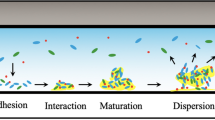Abstract
Studies on chemotaxis of Escherichia coli have shown that modulation of tumble frequency causes a net drift up the gradient of attractants. Recently, it has been demonstrated that the bacteria is also capable of varying its runs speed in uniform concentration of attractant. In this study, we investigate the role of swimming speed on the chemotactic migration of bacteria. To this end, cells are exposed to gradients of a non-metabolizable analogue of glucose which are sensed via the Trg sensor. When exposed to a gradient, the cells modulate their tumble duration, which is accompanied with variation in swimming speed leading to drift velocities that are much higher than those achieved through the modulation of the tumble duration alone. We use an existing intra-cellular model developed for the Tar receptor and incorporate the variation of the swimming speed along with modulation of tumble frequency to predict drift velocities close to the measured values. The main implication of our study is that E. coli not only modulates the tumble frequency, but may also vary the swimming speed to affect chemotaxis and thereby efficiently sample its nutritionally rich environment.








Similar content being viewed by others
References
Adler J (1966) Chemotaxis in bacteria. Science 153:708–716
Adler J, Epstein W (1974) Phosphotransferase-system enzymes as chemoreceptors for certain sugars in Escherichia coli chemotaxis. Proc Natl Acad Sci USA 71:2895–2899
Adler J, Hazelbauer G, Dahl M (1973) Chemotaxis toward sugars in Escherichia coli. J Bacteriol 115:824–847
Ahmed T, Stocker R (2008) Experimental verification of the behavioral foundation of bacterial transport parameters using microfluidics. Biophys J 95(9):4481–93
Alon U, Camarena L, Surette MG, y Arcas BA, Liu Y, Leibler S, Stock JB (1998) Response regulator output in bacterial chemotaxis. EMBO J 17:4238–4248
Barkai N, Leibler S (1997) Robustness in simple bionetworks. Nature 387:913–917
Berg H, Brown D (1972) Chemotaxis in Escherichia coli analysed by three-dimensional tracking. Nature 239:502–507
Berg HC (2000) Random walks in biology. Princeton University Press, Princeton
Berg HC (2004) E. coli in motion. Springer, New York
Boehm A, Kaiser M, Li H, Spangler C, Kasper C, Ackermann M, Kaever V, Sourjik V, Roth V, Jenal U (2010) Second messenger mediated adjustment of bacterial swimming velocity. Cell 141:107–116
Deepika D, Karmakar R, Tirumkudulu MS, Venkatesh KV (2015) Variation in swimming speed of Escherichia coli in response to attractant. Arch Microbiol 197(2):211–222
Demir M, Salman H (2012) Bacterial thermotaxis by speed modulation. Biophys J 103:1683–1690
Eisenbach M (2004) Chemotaxis. Imperial college press, London
Eisenbach M, Wolf A, Welch M, Caplan S, Lapidus I, Macnab R, Aloni H, Asher O (1990) Pausing, switching and speed fluctuation of the bacterial flagellar motor and their relation to motility and chemotaxis. J Mol Biol 211:551–563
Feng X, Lilly A, Hazelbauer G (1999) Enhanced function conferred on low-abundance chemoreceptor trg by a methyltransferase-docking site. J Bacteriol 181:3164–3171
Hayashi K, Morooka N, Yamamoto Y, Fujita K, Isono K, Choi S, Ohtsubo E, Baba T, Wanner BL, Mori H, Horiuchi T (2006) Highly accurate genome sequences of Escherichia coli k-12 strains mg1655 and w3110. Mol Syst Biol 2:2006.2007:1–5
Hazelbauer G, Engstrom P (1980) Parallel pathways for transduction of chemotactic signals in Escherichia coli. Nature 283:98–100
Li M, Hazelbauer G (2005) Adaptational assistance in clusters of bacterial chemoreceptors. Mol Microbiol 56:1617–1626
Liu Z, Papadopoulos K (1995) Unidirectional motility of Escherichia coli in restrictive capillaries. Appl Environ Microbiol 61(10):3567–3572
Liu Z, Papadopoulos K (1996) A method for measuring bacterial chemotaxis parameters in a microcapillary. Biotechnol Bioeng 51(1):120–125
Lux R, Jahreis K, Bettenbrock K, Parkinson JS, Lengeler JW (1995) Coupling the phosphotransferase system and the methyl-accepting chemotaxis protein-dependent chemotaxis signaling pathways of Escherichia coli. Proc Natl Acad Sci USA 92:11583–11587
Macnab R, Koshland D (1972) The gradient-sensing mechanism in bacterial chemotaxis. Proc Natl Acad Sci USA 69:2509–2512
Masson JB, Voisinne G, Wong-Nga J, Celania A, Vergassola M (2012) Noninvasive inference of the molecular chemotactic response using bacterial trajectories. Proc Natl Acad Sci USA 109:1802–1807
Mesibov R, Ordal W, Adler J (1973) The range of attractant concentrations for bacterial chemotaxis and the threshold and the size of response aver this range. J Gen Physiol 62:203–223
Neumann S, Grosse K, Sourjik V (2012) Chemotactic signaling via carbohydrate phosphotransferase systems in Escherichia coli. Proc Natl Acad Sci USA 109:12159–12164
Rivero M, Tranquillo R, Buettner H, Lauffenburger D (1989) Transport models for chemotactic cellpopulations based on individual cell behaviour. Chem Eng Sci 44(12):2881–2897
Saragosti J, Calvez V, Bournaveas N, Perthame B, Buguin A, Silberzan P (2011) Directional persistence of chemotactic bacteria in a traveling concentration wave. Proc Natl Acad Sci USA 108:16235–16240
Subramanian G, Koch DL (2009) Critical bacterial concentration for the onset of collective swimming. J Fluid Mech 632:359–400
Vuppala RV, Tirumkudulu MS, Venkatesh KV (2010a) Chemotaxis of Escherichia coli to l-serine. Phys Biol 7(026):007
Vuppala RV, Tirumkudulu MS, Venkatesh KV (2010b) Mathematical modeling and experimental validation of chemotaxis under controlled gradients of methyl-aspartate in Escherichia coli. Mol Biosyst 6:1082–1092
Wadhams G, Armitage J (2004) Making sense of it all: bacterial chemotaxis. Nat Rev Mol Cell Biol 5:1024–1037
Acknowledgments
The authors acknowledge financial support from the Department of Science and Technology, India. MST also acknowledges support from the Swaranajayanti Fellowship.
Author information
Authors and Affiliations
Corresponding author
Additional information
R. V. S. Uday Bhaskar and Richa Karmakar have contributed equally to this work.
Electronic supplementary material
Below is the link to the electronic supplementary material.
Rights and permissions
About this article
Cite this article
Uday Bhaskar, R.V.S., Karmakar, R., Deepika, D. et al. Variation of swimming speed enhances the chemotactic migration of Escherichia coli . Syst Synth Biol 9, 85–95 (2015). https://doi.org/10.1007/s11693-015-9174-x
Received:
Revised:
Accepted:
Published:
Issue Date:
DOI: https://doi.org/10.1007/s11693-015-9174-x




